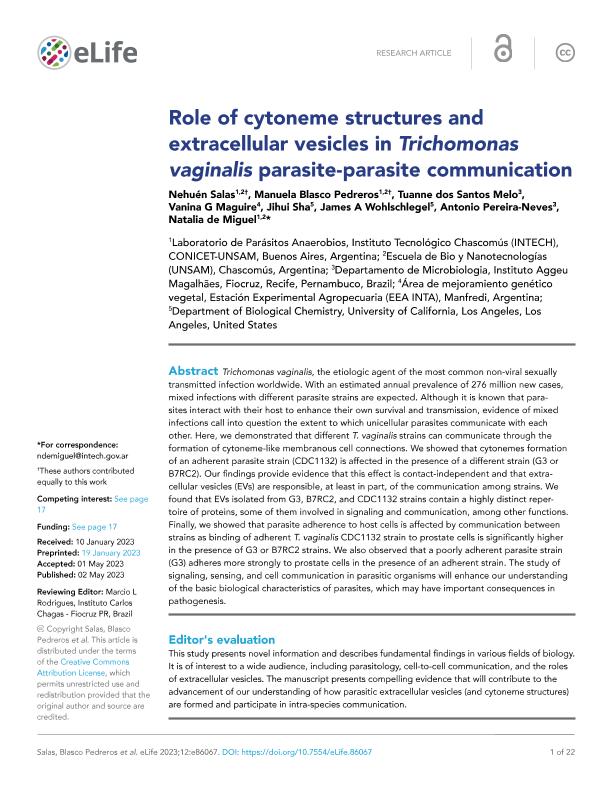Mostrar el registro sencillo del ítem
dc.contributor.author
Salas, Nehuen

dc.contributor.author
Blasco Pedreros, Manuela Pia

dc.contributor.author
dos Santos Melo, Tuanne
dc.contributor.author
Maguire, Vanina Giselle

dc.contributor.author
Sha, Jihui
dc.contributor.author
Wohlschlegel, James A.
dc.contributor.author
Pereira Neves, Antonio
dc.contributor.author
de Miguel, Natalia

dc.date.available
2024-01-30T11:40:47Z
dc.date.issued
2023-05
dc.identifier.citation
Salas, Nehuen; Blasco Pedreros, Manuela Pia; dos Santos Melo, Tuanne; Maguire, Vanina Giselle; Sha, Jihui; et al.; Role of cytoneme structures and extracellular vesicles in Trichomonas vaginalis parasite: Parasite communication; eLife Sciences Publications; eLife; 12; 5-2023; 1-22
dc.identifier.issn
2050-084X
dc.identifier.uri
http://hdl.handle.net/11336/225156
dc.description.abstract
Trichomonas vaginalis, the etiologic agent of the most common non-viral sexually transmitted infection worldwide, colonizes the human urogenital tract where it remains extracellular and adheres to epithelial cells. With an estimated annual prevalence of 276 million new cases, mixed infections with different parasite strains are expected. Although it is considered as obvious that parasites interact with their host to enhance their own survival and transmission, evidence of mixed infections call into question the extent to which unicellular parasites communicate with each other. Here, we demonstrated that different T. vaginalis strains can communicate through the formation of cytoneme-like membranous cell connections. We showed that T. vaginalis adherent strains form abundant membrane protrusions and cytonemes formation of an adherent parasite strain (CDC1132) is affected in the presence of a different strain (G3 or B7RC2). Using cell culture inserts assays, we demonstrated that the effect in cytoneme formation is contact-independent and that extracellular vesicles (EVs) are responsible, at least in part, of the communication among strains. We found that EVs isolated from G3, B7RC2, and CDC1132 strains contain a highly distinct repertoire of proteins, some of them involved in signaling and communication, among other functions. Finally, we showed that parasite adherence to host cells is affected by this communication between strains as binding of adherent T. vaginalis CDC1132 strain to prostate cells is significantly higher in the presence of G3 or B7RC2 strains. Demonstrating that interaction of isolates with distinct phenotypic characteristics may have significant clinical repercussions, we also observed that a poorly adherent parasite strain (G3) adheres more strongly to prostate cells in the presence of an adherent strain. The study of signaling, sensing, and cell communication in parasitic organisms will surely enhance our understanding of the basic biological characteristics of parasites, which may have important consequences in pathogenesis.
dc.format
application/pdf
dc.language.iso
eng
dc.publisher
eLife Sciences Publications
dc.rights
info:eu-repo/semantics/openAccess
dc.rights.uri
https://creativecommons.org/licenses/by/2.5/ar/
dc.subject
PARASITE
dc.subject
COMMUNICATION
dc.subject
VESICLES
dc.subject
TRICHOMONAS
dc.subject
FILOPODIA
dc.subject
PATHOGENESIS
dc.subject.classification
Biología Celular, Microbiología

dc.subject.classification
Ciencias Biológicas

dc.subject.classification
CIENCIAS NATURALES Y EXACTAS

dc.title
Role of cytoneme structures and extracellular vesicles in Trichomonas vaginalis parasite: Parasite communication
dc.type
info:eu-repo/semantics/article
dc.type
info:ar-repo/semantics/artículo
dc.type
info:eu-repo/semantics/publishedVersion
dc.date.updated
2024-01-29T15:22:12Z
dc.journal.volume
12
dc.journal.pagination
1-22
dc.journal.pais
Reino Unido

dc.journal.ciudad
Cambridge
dc.description.fil
Fil: Salas, Nehuen. Universidad Nacional de San Martin. Instituto Tecnologico de Chascomus. - Consejo Nacional de Investigaciones Cientificas y Tecnicas. Centro Cientifico Tecnologico Conicet - la Plata. Instituto Tecnologico de Chascomus.; Argentina
dc.description.fil
Fil: Blasco Pedreros, Manuela Pia. Universidad Nacional de San Martin. Instituto Tecnologico de Chascomus. - Consejo Nacional de Investigaciones Cientificas y Tecnicas. Centro Cientifico Tecnologico Conicet - la Plata. Instituto Tecnologico de Chascomus.; Argentina
dc.description.fil
Fil: dos Santos Melo, Tuanne. Instituto Aggeu Magalhães; Brasil
dc.description.fil
Fil: Maguire, Vanina Giselle. Consejo Nacional de Investigaciones Científicas y Técnicas; Argentina. Instituto Nacional de Tecnología Agropecuaria. Centro Regional Córdoba. Estación Experimental Agropecuaria Manfredi; Argentina
dc.description.fil
Fil: Sha, Jihui. University of California at Los Angeles; Estados Unidos
dc.description.fil
Fil: Wohlschlegel, James A.. University of California at Los Angeles; Estados Unidos
dc.description.fil
Fil: Pereira Neves, Antonio. Instituto Aggeu Magalhães; Brasil
dc.description.fil
Fil: de Miguel, Natalia. Universidad Nacional de San Martin. Instituto Tecnologico de Chascomus. - Consejo Nacional de Investigaciones Cientificas y Tecnicas. Centro Cientifico Tecnologico Conicet - la Plata. Instituto Tecnologico de Chascomus.; Argentina
dc.journal.title
eLife
dc.relation.alternativeid
info:eu-repo/semantics/altIdentifier/url/https://elifesciences.org/articles/86067
dc.relation.alternativeid
info:eu-repo/semantics/altIdentifier/doi/https://doi.org/10.7554/eLife.86067
Archivos asociados
